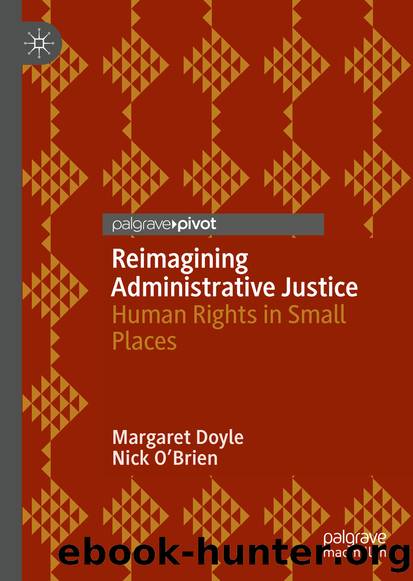Reimagining Administrative Justice by Margaret Doyle & Nick O’Brien

Author:Margaret Doyle & Nick O’Brien
Language: eng
Format: epub
ISBN: 9783030213886
Publisher: Springer International Publishing
Investigation—The Ombud as Flaneur/Flaneuse
Central to ombud-technique, and chief among its claims to offer a viable alternative to adjudication or to mediation as a form of negotiated justice, is the practice of investigation. When the Parliamentary Commissioner Act gave effect to the ombud institution in the UK for the first time in 1967 it granted to the ombud the function of investigating grievances and very little else. It was not the role of the ombud either to adjudicate or mediate but quite simply to investigate, to report on the investigation and to make a recommendation, if she thought necessary. There was no explicit power to make formal findings or provide a remedy for an individual citizen. The very practice of investigation was in itself a form of remedy, a means of clearing the air, shining a light in the dark corners of official administration.
When the ombud was first introduced in Scandinavia, this investigative function also took centre stage. In that case, the residual power of individual citizens to exercise the right to freedom of information was in the case of the ombud writ large and generalised so that the ombud in effect stood in the shoes of the individual citizen and on behalf of the community exercised the right to freedom of information so that what had previously been hidden was now made manifest and open to public gaze. It was the ability of the Scandinavian ombud to ‘glimpse behind the scenes’ of executive action, as the Danish Ombudsman put it (Hurwitz 1960), that prompted the creation of the office in the first place (Busck 1995; Holm 1995).
The centrality of investigation to the work of the ombud is further reflected in the fact that most ombuds, at least outside the UK, have the ability to commence an investigation even without a particular grievance being referred to them by an individual citizen. The availability of this ‘own initiative’ or ‘public value’ investigative power enables the ombud to keep her ear to the ground, to listen out for legitimate grievance, especially on the part of those who might not easily make a formal complaint in person, and to conduct an investigation, so bringing to light for deliberation those circumstances that might otherwise have remained hidden from public view. It is revealing in this regard that in Portuguese ‘ombud’ is sometimes translated as ouvidoria (the auditor or listener), evoking the centrality of this listening function.
Not just listening, but looking also, is an instructive metaphor for this investigative function as central to the ombud technique. In the context of the law, sight is considered a deficit compromising impartiality, but this image of justice as blindfolded is a relatively recent creation. Before the sixteenth century, sight was considered to be ‘essential for justice to manage well the sword and the scale… “the eye of the law” or the “eye of justice”—alert and controlling—was an image of great symbolic value’ (Franca 2018: 171). In the context of urban design, the notion of looking evokes the human perspective
Download
This site does not store any files on its server. We only index and link to content provided by other sites. Please contact the content providers to delete copyright contents if any and email us, we'll remove relevant links or contents immediately.
The Rule of Law by Bingham Tom(1316)
The Holocaust: A New History by Laurence Rees(1232)
Political Theology by Carl Schmitt(1184)
Pirates of Somalia by Jay Bahadur(1112)
Restitution by Restitution(1111)
The Social Animal by David Brooks(1111)
A Practical Guide to International Arbitration in London by Hilary Heilbron(1077)
Coercing Virtue by Robert H. Bork(1022)
The Nuremberg Interviews by Leon Goldensohn(985)
Basic International Corporate Taxation by Sebastiano Garufi(924)
A History Of Thailand by Baker Chris(887)
Asian Waters by Humphrey Hawksley(875)
International Trade and Business: Law, Policy and Ethics by Gabriël Moens & Peter Gillies(867)
Blood Profits by Vanessa Neumann(866)
Spring Fever: The Illusion of Islamic Democracy by McCarthy Andrew C(865)
The Global Commons by Susan J. Buck(861)
Crimes Against Humanity: Historical Evolution and Contemporary Application by M. Cherif Bassiouni(793)
The Sovereignty of Human Rights by Macklem Patrick(789)
The Nuremberg Trials: The Nazis and their Crimes Against Humanity by Roland Paul(788)
